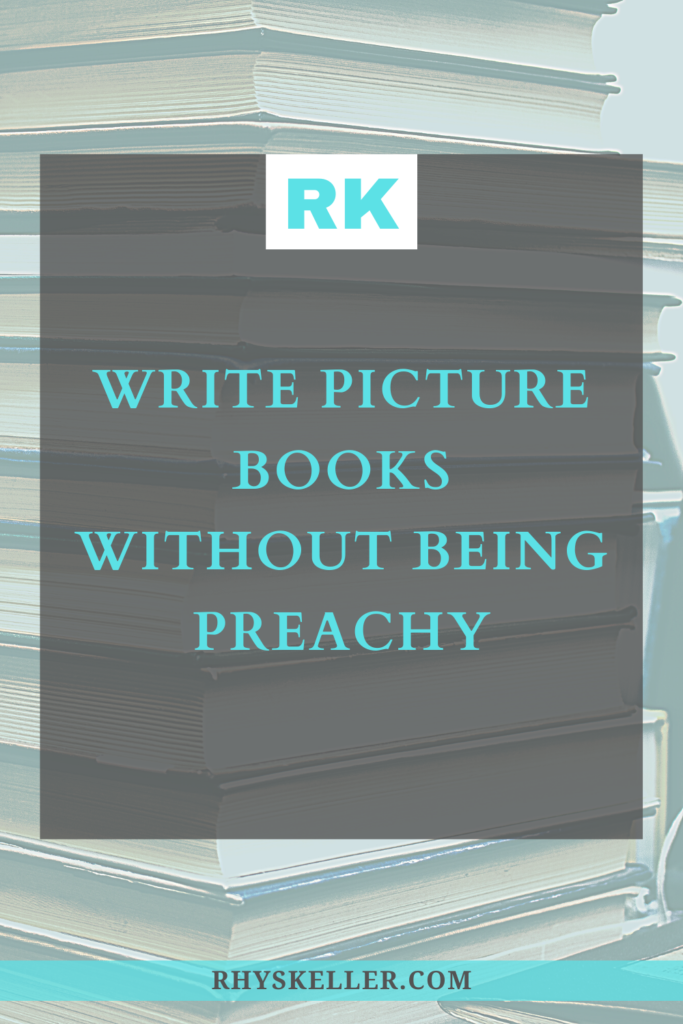Teaching through stories has been around since the dawn of communication. Although when that dawn occurred is hotly contested, what isn’t contested is that stories are excellent methods to communicate a message. They are so excellent, in fact, writers often abuse them by being too preachy. What this really means is that the lesson or purpose in a story, especially in children’s books and even more so if it’s a picture book, should be subtle. Does this come natural to you? Probably not. But it will if you implement these five simple strategies.
When you buy through my links, I may earn money from my affiliate partners. Learn more.
1. Give Your Reader and Listener Some Credit
You may disagree with me on this point, but agents, editors, and publishers don’t. Adult readers, older child readers, and young child listeners are smarter and more intuitive than we think. You may think to yourself, “I know that and agree,” but your writing says otherwise.
It’s easy to tell when an author is not giving their readers or listeners any credit because they spell things out for them. Consider the following sentences:
- Susie fell off her bike. It really hurt and made her frustrated because this was the second time she tried to do it by herself.
- Susie fell off her bike – again!
In the first sentence, we are told what Susie did (she fell), what Susie felt (it really hurt), and what Susie thought (frustrated). We are literally being spoon fed every thought rather than being given the freedom to interpret, understand, or resolve in our own minds what Susie might be experiencing. In the second sentence, all we know if that Susie fell off her bike and it wasn’t the first time.
This simple sentence allows us as the reader or listener to become closer to Susie. It causes us to consider how we would feel or what we would think if we fell off our bike. Would felling off your bike on the hard asphalt pavement hurt you? Definitely! Ouch! That would be painful. Cuts, bruises, scars, blood, oh my! Maybe an adult would consider a broken hand or trip to the emergency room. Then we consider it not being the first time. We feel a flurry of emotions. We are proud that Susie didn’t give up after the first fall but know how frustrating it is to try and fail multiple times. We are rooting for Susie. Keep going Susie! You can do it! Don’t give up!
Will she give up? Will this be the last time she falls? Don’t you want to know? This is tension. I wrote a piece on how to Improve Your Writing with Tension, which is a must read for any aspiring or successfully published author. When we as writers try to force the reader or listener to interpret the story our way, we are reducing the emotional and intellectual impact of the story. Why be 1-Dimensional when we can let imagination take hold to supplement our story?
We authors can also sabotage our readers and listeners by writing outside of their skill set. Even though young children are smart and intuitive, they’re not yet proficient at thousands of adult words. Don’t use big words when little ones will do. Instead of atmosphere, say sky. Instead of automobile, say car. Unless you’re author purpose in the story is to teach some new words, use the words they already know. This helps you communicate your message effectively, which is a big, big deal.
If you haven’t examined your manuscript through a service like WordCounter or WordCountTools, you have likely written for the wrong audience. I’ve written elsewhere on Writing for the Right Picture Book Audience. I encourage you to read it and evaluate your story.
2. Teach Author’s Purpose
You and I often write with a purpose in mind. Sometimes the purpose presents itself after the manuscript draft is written. Regardless, there is always a purpose to a story. My purposes are often social to communicate the benefit or consequence of an action, like in the following sentence:
- Max raced through the open door and growled at the neighbor’s cat. “No!” shouted Ben. “Don’t hurt her!”
Without knowing any more of the story, it’s easy to tell what the purpose of the story is. Don’t leave the door open! If you do, things happen, such as Max getting out (who is a dog but your imagination may have interpreted it differently because I didn’t spoon feed you the description – perhaps Max is a tiger? A bear? Ohh, maybe a ferret?)
How do we teach our author purpose without spoon feeding it to the reader or listener and coming across preachy? We simply let it be inferred rather than heard.
Let’s say I want to teach you about washing your hands. Which of the following stories is preachy? Which one spoon feeds details? Which one could you expect to be in a children’s picture book?
- “Jillian,” Mom began in a condescending tone, “your hands are as dirty as a mud puddle!” “But Mom,” Jillian protested, “It’s only a little-“. “No but anything,” Mom said, interrupting her. “If you don’t wash your hands you could get sick!”
- Jillian sneezed and flung dirt all over her dinner.
This is probably a perfect time to introduce you to editing. Word cutting. Axing. Slicing and dicing. Do you struggle with reducing word count? It’s possible. All you need to do is re-imagine your story from a different perspective. Use different words. Maybe even change the tense. It takes less words to describe something in first person point-of-view than it does third-person limited. Or perhaps an omniscient perspective might enable you to cut the fat.
But back to the issue at hand. Kids don’t enjoy reading preachy books. Adults don’t enjoy reading preachy books. Agents, editors, and publishers don’t enjoy preachy books. So, why write them? The only way to truly get your author purpose to the reader and listener is if it can be inferred rather than heard. Sure, there is always an exception to the rule. But guess what? Assume you’re not the exception and thank me later.
3. Allow Room for Interpretation
There’s nothing more stifling as a reader when you are forced into the corner. Dirty hands make you sick! Well, what if they don’t? What if instead that dirty hand had a worm on it? What if I care more about not eating a worm than I do about not getting sick? Think about it. Do you think your story will stand the test of time if there is no room for interpretation?
There are college courses on art interpretation. Many of the best classic books end with ambiguous endings that cause readers to fall into a tail spin! How many Harry Potter fan theories are there on Reddit? If J.K. Rowling laid it all out for us about the Boy Wizard and his infamous friends, no one would have room to interpret.
Many times, you and I can become so close to our writing that we want to spell it all out for the reader. We want them to get our author purpose exactly. If they read our story about Susie’s dirty hands and come to the conclusion that it’s because of how gross worms are, would we be OK with that? We must be OK with that. The harsh reality is no one wants to read a book that lays out clear author purposes. We readers and listeners want mystery, intrigue, possibilities, freedom to imagine, and a sense that the author doesn’t think us too dull to come to our own conclusion.
Consider my book review of Sam and Dave Dig a Hole by Mac Barnett and Jon Klassen. This story is chock-full of ambiguity and mystery. With only a handful of words, they crafted a story that has caused the most brilliant among us to go into an intellectual tail spin while not forgetting the child reader or listener. Everyone can come to their own conclusion regarding how the book ends, what it means, and what will happen next. It’s truly superb!
Your story can be that superb! But you must leave a little to the imagination. Let readers and listeners come to their own conclusions about your subtle message.
4. Write Creatively
Do you know the best way to teach someone? You make it fun. Things that are fun not only lodge deeper in our minds and hearts, they also captivate us. To be a captivating writer, you must conquer the distractions of our day. Those distractions are not just video games and TV, but prejudices and tastes.
Creative writing allows us to breakthrough the wall of other things competing for the listener’s attention. Write something never written before and you’ll break through. Write something hilarious and you’ll break through. Write with tension and you’ll break through. However you do it, keep creativity in mind early in your manuscript drafting process. If it sounds familiar, it’s (usually) not good enough. Edit and rewrite until what you’ve written stands out from the crowd, delights the reader and listener, and breaks through the wall of distraction.
Writer’s Treasure posted an excellent article on Creative Writing vs. Technical Writing that’s worth your time. I love their definition of creative writing which says, “Creative writing is written to entertain and educate.” Does that describe your book? Does your manuscript entertain and educate? Or does it only entertain? Does it only educate?
I recently shared strategies to Write for the Right Audience. Along the same vein, successful stories should entertain and educate. You can be successful creating content that is only one instead of both but you’re sabotaging yourself. Focus on educating and entertaining. An easy way to know if you’re manuscript is preachy is if it’s primarily educational with little entertaining value. The best children’s book authors educate and entertain.
Before we move on to the 5th strategy to make your writing less preachy, Writer’s Treasure has another great piece on How to Improve Your Creative Writing that really deserves a read.
5. Don’t Be So Serious
Full disclosure. I really struggle with not being too series in my creative writing. Although my background is primarily in creative writing, my entire professional career has been in technical writing. I’ve been successful merging and distancing the two but I had to experience a variety of failures to figure it out.
At the heart of writing more interesting content that isn’t preachy is understanding your audience. If you’re writing a medical non-fiction book for hospitals to consider purchasing for their waiting rooms, OK, consider being a little more educational and a little less entertaining. But, like me, if your targeting the children’s book market, the majority of your audience is is looking for highly entertaining content and moderate to low educational content. If you find this fact difficult to accept, you probably struggle with writing preachy content.
Brightly made a great post on The Hands-Down Funniest Books for Kids. Your homework, should you choose to accept it (accept it!), is to check a bunch of these books out at your local library. Try to pick up on the humor. They contain incredibly entertaining stories. Jon Klassen’s I Want My Hat Back is a wonderful example of writing humor for children. Do you think Jon takes himself too seriously? No way. Do you think Jon understands his target audience? Most definitely.
There you have it. Five simple strategies to write less preachy stories. Which was your favorite? Which is the most difficult to implement? Leave your thoughts below!





Mimi Bond
March 19, 2021Thank you! This article was helpful.
Rhys Keller
March 19, 2021Thank you for reading and sharing your thoughts, Mimi! Trusting our readers’ intelligence to pick up on the fun, subtle little things between the lines makes for such a better story! Happy writing.
Writing Strategies for Authors | Rhys Keller
July 31, 2018[…] a balance that most authors need to seek. In Write Picture Books Without Being Preachy, I discuss why this is such an important topic. The short version is readers want to have a good […]
10 Best Picture Books for Boys | Rhys Keller
July 2, 2018[…] Another hilarious book from Mo Willems that puts the reader in the drivers seat. My boys shouted and yelled and laughed at the pigeon’s crazy antics. Through it all, it’s a perfect example of how to Write Picture Books Without Being Preachy! […]
aubreyleaman
June 26, 2018YES I love this! Great tips!
rhyskeller
June 26, 2018Thank you, Aubrey!